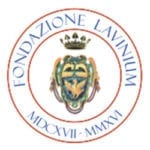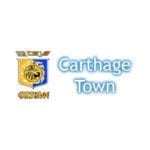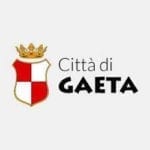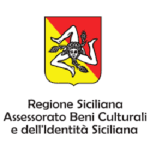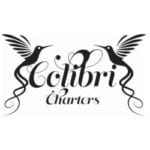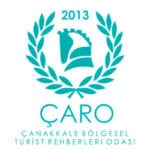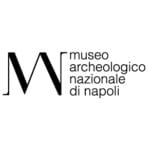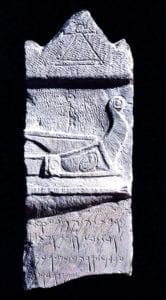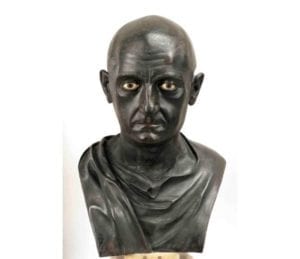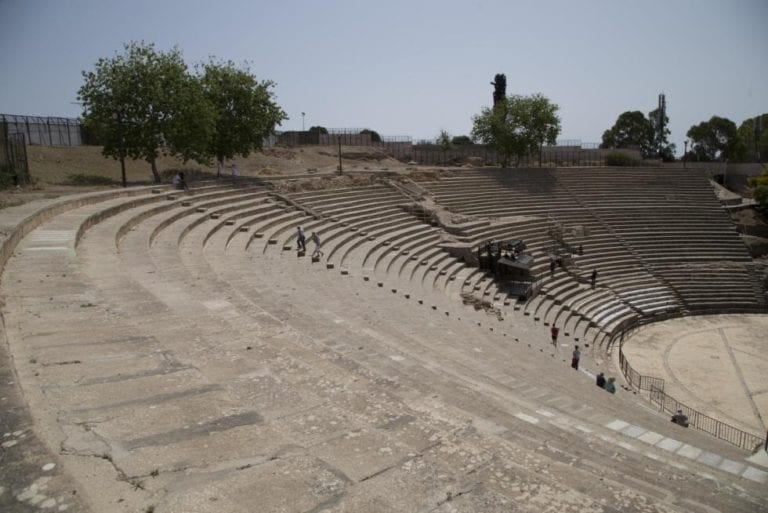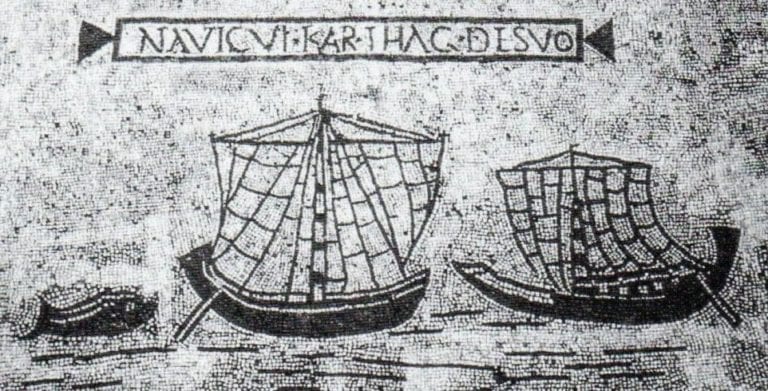Carthage
Carthage

Phoenician Carthage and Mediterranean Sea
According to the tradition Carthage, «Qart Hadasht» (“the new city”), was founded in 814 b.C. by the Phoenician princess Elissa-Didone.Approfondimenti
Informazioni aggiuntiveLa città è strettamente legata al racconto del mitico viaggio di Enea, cantato da Virgilio nell’Eneide, come punto di arrivo dell’eroe troiano sulle coste laziali.
Secondo la tradizione ripresa da Virgilio, infatti, appena sbarcato Enea fece il primo sacrificio, in un luogo presso il fiume Numico (oggi Fosso di Pratica: Numico_1), dove poi sarebbe sorto un santuario dedicato a Sol Indiges. Inseguendo una scrofa bianca gravida, l’eroe percorse una distanza di 24 stadi: qui la scrofa partorì trenta piccoli e il prodigio offrì ad Enea un segno della volontà degli dei di fermarsi e fondare una nuova città. L’eroe incontrò Latino, il re della locale popolazione degli Aborigeni, il quale, dopo aver consultato un oracolo, capì che i nuovi arrivati non dovevano essere considerati degli invasori, ma come uomini amici da accogliere. Enea sposò dunque la figlia di Latino, Lavinia, e fondò la città di Lavinium, celebrando la nascita di un nuovo popolo, nato dalla fusione tra Troiani e Aborigeni: il popolo dei Latini. Il mito racconta che Enea non morì, ma scomparve in modo prodigioso tra le acque del fiume Numico e da questo evento fu onorato come Padre Indiges: Il padre capostipite.
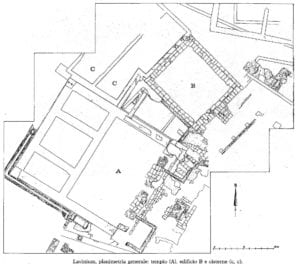 La piazza pubblica della città aveva una pianta rettangolare, ornata sui lati lunghi da portici, su cui si aprivano diversi edifici: uno di questi aveva forse la funzione di “Augusteo”, luogo dedicato al culto imperiale, come sembra indicare il ritrovamento di splendidi ritratti degli imperatori Augusto, Tiberio e Claudio. Sul lato corto occidentale si affacciavano un edificio elevato su un podio, forse la Curia (luogo di riunione del governo locale), e un tempio, risalente ad età repubblicana.
La piazza pubblica della città aveva una pianta rettangolare, ornata sui lati lunghi da portici, su cui si aprivano diversi edifici: uno di questi aveva forse la funzione di “Augusteo”, luogo dedicato al culto imperiale, come sembra indicare il ritrovamento di splendidi ritratti degli imperatori Augusto, Tiberio e Claudio. Sul lato corto occidentale si affacciavano un edificio elevato su un podio, forse la Curia (luogo di riunione del governo locale), e un tempio, risalente ad età repubblicana.
Il santuario, situato ad est della città antica, era dedicato alla dea Minerva, che a Lavinium è dea guerriera, ma anche protettrice dei matrimoni e delle nascite. È stato trovato un enorme scarico di materiale votivo databile tra la fine del VII e gli inizi del III sec. a.C., costituito soprattutto da numerose statue in terracotta raffiguranti soprattutto offerenti, sia maschili che femminili, alcune a grandezza naturale, che donano alla divinità melograni, conigli, colombe, uova e soprattutto giocattoli: le offerte simboleggiano l’abbandono della fanciullezza e il passaggio all’età adulta attraverso il matrimonio
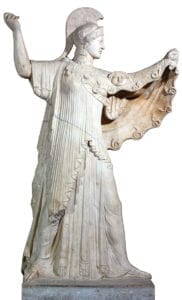 Eccezionale il ritrovamento di una statua della dea, armata di spada, elmo e scudo e affiancata da un Tritone, essere metà umano e metà pesce: questo elemento permettere di riconoscere nella raffigurazione la Minerva Tritonia venerata anche in Grecia, in Beozia, e ricordata da Viirgilio nell’Eneide (XI, 483): “armipotens, praeses belli, Tritonia virgo” (O dea della guerra, potente nelle armi, o vergine tritonia…)
Eccezionale il ritrovamento di una statua della dea, armata di spada, elmo e scudo e affiancata da un Tritone, essere metà umano e metà pesce: questo elemento permettere di riconoscere nella raffigurazione la Minerva Tritonia venerata anche in Grecia, in Beozia, e ricordata da Viirgilio nell’Eneide (XI, 483): “armipotens, praeses belli, Tritonia virgo” (O dea della guerra, potente nelle armi, o vergine tritonia…)
Il culto del santuario meridionale nasce in età arcaica ed era caratterizzato da libagioni. Nella fase finale il culto si trasforma invece verso la richiesta di salute e guarigione, documentato dalle numerose offerte di ex voto anatomici. Sono state trovate iscrizioni di dedica che ricordano
Castore e Polluce (i Dioscuri) e la dea Cerere. La molteplicità degli altari e delle dediche è stata interpretata come testimonianza del carattere federale del culto, quindi legato al popolo latino nel suo insieme: ogni altare potrebbe forse rappresentare una delle città latine aderenti alla Lega Latina, confederazione che riuniva molte città del Latium Vetus, alleatesi per contrastare il predominio di Roma.
Dionigi di Alicarnasso, vissuto sotto il principato di Augusto, afferma di aver visto in questo luogo, ancora al suo tempo, nel I sec. a.C., due altari, il tempio dove erano stati posti gli dèi Penati portati da Troia e la tomba di Enea circondata da alberi: «Si tratta di un piccolo tumulo, intorno al quale sono stati posti file regolari di alberi, che vale la pena di vedere» (Ant. Rom. I, 64, 5)
Alba
Lavinium fu considerata anche il luogo delle origini del popolo romano: all’immagine di Roma nel momento della sua espansione e della crescita del suo potere era utile costruire una discendenza mitica da Enea, figlio di Venere, onorato per le sue virtù, per la capacità di assecondare gli dèi; di conseguenza si affermò anche la tradizione per la quale Romolo, il fondatore di Roma, aveva le sue origini, dopo quattro secoli, dalla medesima stirpe di Enea.
Secondo questa tradizione Ascanio Iulo, il figlio di Enea, aveva fondato Alba Longa, città posta presso l’attuale Albano, dando l’avvio a una dinastia, che serviva per colmare i quattrocento anni che separano le vicende di Enea (XII sec. a.C.) dalla fondazione di Roma (VIII se. a.C.), quando, dalla stessa stirpe, nacquero i gemelli Romolo e Remo, secondo la tradizione allattati da una lupa. Questi erano dunque i nipoti del re di Alba Longa. La madre era Rea Silvia e il padre il dio Marte. Romolo uccise Remo e poi fondò Roma nel 753 a.C. Lavinium diventava così la città sacra dei Romani, dove avevano sede i “sacri princìpi del popolo romano”.
Il Borgo sorge su una altura occupata nell’antichità dall’acropoli di Lavinium. In età imperiale vi sorge una domus, testimoniata da pavimenti in mosaico in bianco e nero (Borgo_1). Una civitas Pratica è ricordata per la prima volta in un documento del 1061, mentre nell’epoca successiva si parla di un castrum che fu di proprietà del Monastero di San Paolo fino al 1442. La Tenuta di Pratica di Mare, comprendente anche il Borgo, allora definito “Castello” (Borgo_2), divenne poi proprietà della famiglia Massimi e in seguito fu acquistata nel 1617 dai Borghese. Il principe Giovan Battista, nel tentativo di valorizzare il territorio con l’agricoltura, ristrutturò il villaggio nella forma che ancora oggi rimane, caratteristica per la sua pianta ortogonale e la sua unitarietà. Dalla metà dell’Ottocento la malaria, che devastava la campagna romana, causò lo spopolamento del borgo, finché Camillo Borghese dal 1880 si impegnò nell’opera di ricolonizzazione, restaurando il palazzo e intervenendo con una importante opera di riassetto della tenuta, dove fu impiantata una singolare vigna a pianta esagonale. Il Borgo e la tenuta rappresentano una preziosa area monumentale e agricola ancora intatta all’interno della zona degradata di Pomezia e Torvaianica.
The clash with Rome: the Punic Wars
Consequently the first agreement with Rome, other treaties of military and commercial nature was established between Carthage and the Romans (in 348, 306 and 279-8) but with the time the rivalry for the hegemony in the Mediterranean Sea heightened even more between Rome, the greatest expanding power of that time and Carthage, a city with a marked commercial vocation. The first conflict (264-241 b.C.) unleashed for the possession of Sicily, situated at the centre of Mediterranean Sea, in a very strategic position and precious granary. The battle took place mainly on the sea and ended with the victory of Rome but with huge losses for both. The protagonist of the second Punic War (218-201 b.C) was Hannibal, the great strategist who crossed the Alps and inflicted to Rome several defeats on Italian territory with severe distructions and almost 200.000 deaths; but Scipio Africanus, carried the war to Africa and in Zama he obtained a definitive victory (202 b.C). The last Punic War (149-147 b.C) represented the third and final act of a long rivarly: the Carthagines started to rearm their armies and to rebuild the harbour. Rome, alarmed by these initiatives tried to impose to the citizens to abandone the city and to rebuild the settlement at 90 stade of distance from the sea.The distruction
After two years of siege, P.Cornelius Scipio Aemilianus expunged the city in 146 b.C.; he interrupted the isthmus linking the settlement to the main land and built an high watchtower closing the access to the harbours, blocking definitively the city which burned for 17 days. Carthage was cursed and forbidden to all. The possessions of the city was annexed to the bigger province of Africa with Utica as capital.La reconstruction and the Roman colony
A first project of reconstruction for the city was conceived in 123 b.C. when the Lex Rubria, wanted by Caius Gracchus decided to send there 6000 settlers in order to establish the Iunonia Carthago colony. The initiative had no success. In 46 b.C. after the victory of Julius Caesar over the Numidians, Rome decided to revive Carthage: the Concordia Iulia Carthago was established and become the great capital of the Proconsular province of Africa. Numerous settlers was sent and the territories dived to start the construction of private houses and public buildings: the city under construction of the queen Dido visited by Aeneas in the Aeneid is actually the new Carthage of the Augustan era at the time of Virgil.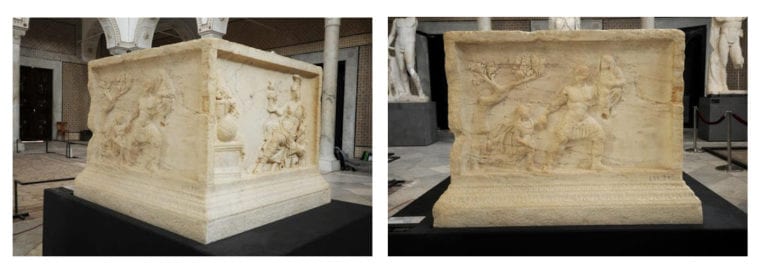
(crédit photos INP et AMVPPC)
INTRODUCTION
Carthage was the most important colony founded by the Phoenicians in the western Mediterranean. Situated at the intersection of the routes which linked North Africa to Egypt, East, Italian and Iberian Peninsulas, this city gave an enormous contribute to the development of Mediterranean civilisation. Punic metropolis at the beginning and then capital of the African Romance province, during its history Carthage has been always opened to the “Mare Nostrum”; a city which gave and took a lot. In the Aeneid, Carthage is the theatre of the touching history of passion, love, abandonment and death between the Phoenician Dido and the Trojan Aeneas.
Contacts
Map
Modulo di contatto
Donec leo sapien, porta sed nibh rutrum, bibendum posuere libero.
